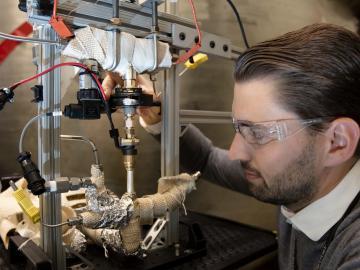
Filter News
Area of Research
- (-) Materials (42)
- (-) Neutron Science (13)
- (-) Supercomputing (32)
- Advanced Manufacturing (1)
- Biology and Environment (13)
- Computer Science (1)
- Electricity and Smart Grid (1)
- Energy Science (38)
- Fusion and Fission (3)
- Isotopes (1)
- Materials for Computing (5)
- National Security (13)
- Nuclear Science and Technology (3)
- Quantum information Science (4)
News Type
News Topics
- (-) Grid (3)
- (-) Machine Learning (10)
- (-) Materials Science (28)
- (-) Microscopy (9)
- (-) Physics (15)
- (-) Quantum Science (11)
- (-) Transportation (9)
- 3-D Printing/Advanced Manufacturing (7)
- Advanced Reactors (1)
- Artificial Intelligence (23)
- Big Data (16)
- Bioenergy (8)
- Biology (8)
- Biomedical (14)
- Biotechnology (1)
- Buildings (3)
- Chemical Sciences (9)
- Clean Water (3)
- Composites (2)
- Computer Science (50)
- Coronavirus (9)
- Cybersecurity (2)
- Energy Storage (9)
- Environment (21)
- Exascale Computing (16)
- Fossil Energy (1)
- Frontier (17)
- Fusion (3)
- High-Performance Computing (25)
- Hydropower (1)
- Isotopes (7)
- Materials (25)
- Mathematics (2)
- Nanotechnology (12)
- National Security (3)
- Neutron Science (61)
- Nuclear Energy (12)
- Partnerships (3)
- Polymers (6)
- Quantum Computing (12)
- Security (3)
- Simulation (12)
- Software (1)
- Space Exploration (3)
- Summit (22)
Media Contacts

A rapidly emerging consensus in the scientific community predicts the future will be defined by humanity’s ability to exploit the laws of quantum mechanics.

A team of scientists led by the Department of Energy’s Oak Ridge National Laboratory and the Georgia Institute of Technology is using supercomputing and revolutionary deep learning tools to predict the structures and roles of thousands of proteins with unknown functions.

Neuromorphic devices — which emulate the decision-making processes of the human brain — show great promise for solving pressing scientific problems, but building physical systems to realize this potential presents researchers with a significant

A team led by the U.S. Department of Energy’s Oak Ridge National Laboratory demonstrated the viability of a “quantum entanglement witness” capable of proving the presence of entanglement between magnetic particles, or spins, in a quantum material.

The daily traffic congestion along the streets and interstate lanes of Chattanooga could be headed the way of the horse and buggy with help from ORNL researchers.

A multidisciplinary team of scientists at ORNL has applied a laser-interference structuring, or LIS, technique that makes significant strides toward eliminating the need for hazardous chemicals in corrosion protection for vehicles.

At the Department of Energy’s Oak Ridge National Laboratory, scientists use artificial intelligence, or AI, to accelerate the discovery and development of materials for energy and information technologies.

For a researcher who started out in mechanical engineering with a focus on engine combustion, Martin Wissink has learned a lot about neutrons on the job

On Feb. 18, the world will be watching as NASA’s Perseverance rover makes its final descent into Jezero Crater on the surface of Mars. Mars 2020 is the first NASA mission that uses plutonium-238 produced at the Department of Energy’s Oak Ridge National Laboratory.

Since the 1930s, scientists have been using particle accelerators to gain insights into the structure of matter and the laws of physics that govern our world.


